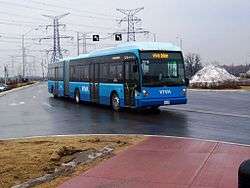Van Hool
 | |
| Private | |
| Industry |
Automotive manufacture Automotive engineering |
| Founded | 1947 |
| Headquarters | Koningshooikt, Belgium |
Key people |
Bernard Van Hool (founder) Filip Van Hool (CEO) |
| Products |
Bus Coach Semi-trailers |
| Subsidiaries | Van Hool USA |
| Website | vanhool.com |
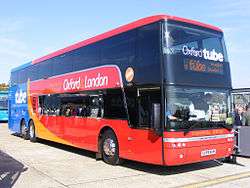
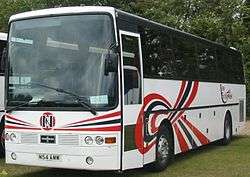

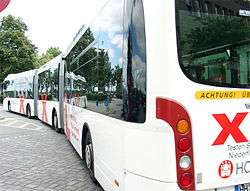
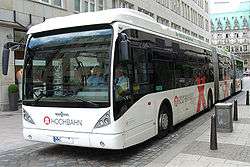
Van Hool NV (Dutch pronunciation: [vɑn ˈɦoːl]) is a Belgian family-owned coachbuilder and manufacturer of buses, coaches, trolleybuses, and trailers.
The company was founded in 1947 by Bernard van Hool in Koningshooikt, near Lier, Belgium. In the early years, the company introduced serial production and exported their products all over Europe. Since the mid-1980s, the company has also been active on the North American market, where it has become an important player.
On February 15, 1957, Van Hool signed a commercial agreement with Fiat; Van Hool would incorporate Fiat engines and other mechanical components (gearboxes, axles, steering) in its vehicles. It developed from a coachbuilder to a Belgian manufacturer of integral buses and coaches, known as Van Hool-Fiat. Alongside these activities, the company continued as a renowned coachbuilder, enabling further expansion.
The Van Hool-Fiat co-operation was immediately a great success: a year and a half after the agreement was signed, in August 1958, the 100th Van Hool-Fiat was delivered, and by July 1961, the figure had exceeded 500. The co-operation agreement with Fiat was terminated in 1981.
In 1990, Van Hool purchased the coachbuilding business of LAG Manufacturing and continued producing their EOS models for about ten years.
Most of the buses and coaches are built totally by Van Hool, with engines and axles sourced from Caterpillar, Cummins, DAF and MAN and gearboxes from ZF or Voith, with some of their production still consisting of building bus and coach bodies on separate bus chassis from manufacturers such as Volvo and Scania.
Worldwide, Van Hool employs 4,500 people and manufactures over 1,700 buses and coaches (bodyworks and complete vehicles combined) and 5,000 trailers each year. It sells an average of 600 coaches, annually, in the United States.
Product range (Europe)
In Europe, Van Hool has the broadest range of coaches of all manufacturers on the market, though all designs share similar looks and are based on the same platform, the T9. The same philosophy is used on the transit bus range, the A-series. Many different versions are available, all sharing the same looks. In recent years, the company has been focussing on new propulsion technologies, introducing fuel-cell hybrid buses as well as diesel-electric hybrids.
Discontinued products
T8 series touring coach
The T8 platform was introduced in 1979. The body was based on the Alizee bodywork that had been launched the previous year. Over the course of several years, a large range of touring coaches were developed based on this platform, each distinguished by a number and a name, following a clear naming convention. For example, in "TD824 Astromega":
- T = Touringcar (touring coach)
- D = Dubbeldek (double deck)
- 8 = Part of the T8 series
- 24 = theoretical maximum number of seat rows
- Astromega = name of the double deck integrals
In 1991, an updated "T8 New Look" was introduced, called the T9 in its North American version. Production was ended in the late 1990s, following the introduction of the new (European) T9 platform.
A-series transit bus
In the 1980s, European countries started to move away from standard bus designs, leaving the design of transit buses to the manufacturers. Van Hool's response was the development of the A-series transit buses. The first member, the A500, was introduced in 1985. A complete family would follow, again following a clear naming convention. For example, in 'AG500':
- A = Autobus (transit bus)
- G = Geleed (articulated)
- 500 = height of the floor, in millimeters
Production of the A-series continued into the early 21st century, when it was replaced by the newA-series.
Current products
T9 series touring coaches
The new T9 series (not to be confused with the T9 series in the United States market, which corresponds with the European T8 New Look) was launched in 1995. It included a completely new body design, as well as many other improvements. The same philosophy as with the T8 was applied: one platform, many different versions. Also, the naming convention was retained. Over the years, many new variants have been developed, making the T9-series the most extensive series of motorcoaches available today. Different models (all available in at least 2 lengths, see 'products' below) include the Atlino and Atlon, so-called double earners, with different floor heights, the Alicron, Acron and Astron, standard touring coaches with different heights and thus different luggage space, the Altano, which has an underfloor cockpit, the Astronef, which features a sloping theatre-style floor, and the double deck Astromega.
Additionally, the T9 body is also available on chassis by Scania, Volvo and VDL, though only in Sweden and on the British Isles. These motorcoaches are referred to as Alizee (single deck) and Astrobel (double deck).
TX series touring coaches
At Busworld 2011 in Kortrijk, Belgium, Van Hool presented the successor to the T9 series. The new series is called TX.
newA series transit buses
In 2001, Van Hool introduced the newA series transit buses, replacing the A series. It featured a new body design and many other improvements. A complete family was developed, with different length and configurations.
ExquiCity BRT solution
In April 2011 Van Hool launched a new Multi Propulsion Platform called ExquiCity, aimed specifically at the BRT market. The bus has the styling and comfort of a tram, with the flexibility and cost of a bus. The ExquiCity was launched in two lengths, the single-articulated ExquiCity 18 and the double-articulated ExquiCity 24. Both are available as trolley buses, diesel-electric hybrids, fuel-cell hybrids or full-electric buses. First orders were placed by the Italian city of Parma (ExquiCity 18 trolley) and the French city of Metz (ExquiCity 24 diesel electric hybrid). A mock-up was presented at the UITP Congress in Dubai.
EX series touring coaches
At the Internationale Automobil-Ausstellung 2014 in Hanover, Germany, Van Hool presented a new series of touring coaches for the European market. This new line is called EX. It is produced in the Van Hool factory in Skopje, the capital of the Republic of Macedonia. Macedonia is considered to be a low-wage country where production costs are much lower than in Belgium.[1]
Product range (North America)
Due to American Federal Safety requirements and other unique factors, only highway touring coaches were introduced in the United States initially. Transit coaches by Van Hool were not introduced until 2002. Currently, Van Hool has four separate product lines for sale: the TX series deluxe touring coaches, the CX series touring coaches, the TD925 and TDX double-decker coach, and the A-series transit buses. Van Hool's exclusive dealer in the United States is ABC Companies.
Discontinued products
T8 series touring coach
The T815 was first introduced to the United States market in 1987. Later subsequent models are collectively known as the T8 series. The earliest use Cummins L10 diesels. Later versions use Cummins M11 diesels.
It was available as 30,-40-and-45-foot (9.1, 12.2 and 13.7 m) length versions.
T9 series touring coach
T9 series are almost identical to the T8 series visually, and are largely identical mechanically as well, except for incremental updates. T9 series upgraded the suspension airbags to larger heavy-duty versions, as well as upgraded front axle to disc brakes instead of drum brakes. However, many of the earliest T9's indeed lack these upgrades. Van Hool's VIN consider T8 and T9 to be the same family.
It was available as 40-foot (12.2 m) T940 or extended 45-foot (13.7 m) T945 versions.
Current products
T21 series luxury touring coach
Introduced in 1995 and based on the European T9 platform, the T21 series features an updated stream-line design and more engine choices. Whereas T8 and T9 series are almost exclusively powered by Cummins diesel engines, T21 are available with Cummins M11 plus engine, Detroit Diesel series 60 engine, or the latest Caterpillar C13 ACERT "clean diesel" engine. Most recent versions simplified the windshield into two panes only, replaced headlight assemblies with individual projector lamps, and consolidated the driver console.
Available as 40-foot (12.2 m) T2140 or extended 45-foot (13.7 m) T2145 versions.
C20 series touring coach
Introduced as a lower-cost coach intended for long-line duty, the C20 series, with similar European looks to the T21 series, was introduced in 2000 to the United States market. C20 is available with Cummins ISX12 or Detroit Diesel DD13 engine. Previous generations could also be equipped with Cummins M11 plus, Cummins ISM, Detroit Diesel series 60 and Caterpillar C13 engine. Both Allison B500 automatic and ZF AS Tronic automated gearboxes are available.[2]
Greyhound operates a fleet of C2045s along with its MCI buses in Michigan.
Available as extended 45-foot (14 m) C2045 version only. Current model is C2045E.
A3 transit bus series
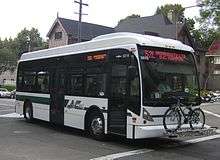
The popularity of A3 series in Europe led Van Hool and ABC to partner with AC Transit (Alameda and Contra Costa counties, California) to demonstrate the A3 series as a future transit alternative in 2002. The A330 and AG300 low floor transit coaches formally entered service in AC transit fleet in June 2003. AC Transit has over 290 Van Hool buses either in its fleet or on order as of August 2016.
Van Hool was building 16 hydrogen fuel cell buses for the United States as of August 2009. These buses are powered by fuel cells from UTC Power and lithium batteries from EnerDell. Twelve of the buses are being purchased by AC Transit and four by CT Transit of Hartford, Connecticut. This project is unusual in that the buses have been designed from the ground up as fuel cell buses and are designed, built, and integrated by a single manufacturer.
The AG300 is an articulated 60-foot (18.3 m) bus, while the A330 is a 40-foot (12.2 m) bus.
In 2008, AC Transit took delivery of a fleet of new model A300L 40-foot (12.2 m) buses. These buses are unique in the United States market as they have their engines mounted in the wheelbase which makes their ride quality extremely stable and smooth. The new layout capitalizes on basic architectural design of the A300L's earlier released little brother the 30-foot (9.1 m) A300K (K stands for kort, "short" in Dutch and L for lang, "long"). A recent survey of AC Transit riders overwhelmingly approves of the design and quality of the new buses.
Salt Lake City (Utah Transit Authority) has purchased ten A300L 40-foot (12.2 m) buses for its MAX Bus Rapid Transit system. These buses differ from AC Transit's A300Ls as they have three doors and are equipped for cold weather and high altitude operations. They have also recently placed an order for four more because of overwhelmingly positive support of the first 10 buses and the "MAX" BRT service they operate.
York Region Transit (north of Toronto, Ontario) uses the A330 and AG300 buses on its Viva routes, though the A330 buses are being transferred to the conventional YRT service as more Nova LFX buses arrive for the Viva services. The Reseau de transport de Longueuil (south of Montreal, Quebec) also uses the AG300 buses, and was the first to use Van Hool transit buses in North America (AG700) in 1989.
Washington, D.C.'s Circulator uses the A330 buses. These 29 buses were purchased from AC Transit in 2005. In addition to the A330 models, the Circulator now uses the new A300K buses, which first went into service in April 2009. The Circulator recently took delivery of 14 A300K, 31-foot (9.4 m) buses to build out its route structure. The A300K was chosen because of its unique ability to do the work of 40-foot (12.2 m) buses for nearly all operations in the smaller envelope and with the smaller engine of a midi bus.
FirstTransit took delivery of 12 A300Ls and 4 AG300s in early 2009, for use on the University of Minnesota Campus Connector.
Baltimore, Maryland's Charm City Circulator have recently ordered and since put 5 A300Ls into service early 2011. The A300L was a supplement order to their already existing, but rehabilitating Designline buses.
TD925 Astromega double-deck touring motorcoach
The TD925 Astromega is a closed-top double-decker motor coach meeting United States specifications that is a variant of the TD925 Astromega coach, available in Europe.
Products
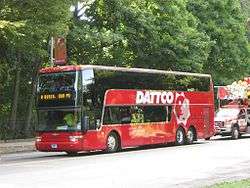
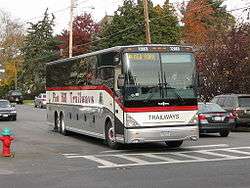
Transit buses
Europe
- A308 midibus, full low floor, with side-mounted engine. Also available as diesel-electric hybrid
- A309 midibus, low entry (low floor up to the second door). Also available as diesel-electric hybrid
- A320 standard bus (out of production)
- A300 standard bus, full low floor, with side-mounted engine. Also available as diesel-electric hybrid
- A300 CNG standard bus
- A360 standard bus, low entry. Also available as diesel-electric hybrid
- A330 standard bus, full low floor, engine placed horizontally in the back. Also available as diesel-electric hybrid
- A330 CNG standard bus
- AG300 articulated bus, also available as diesel-electric hybrid
- AGG300 bi-articulated bus
- A330T trolleybus
- AG300T articulated trolleybus
- AG300 CNG articulated bus
- ExquiCity 18 articulated BRT bus (diesel electric hybrid, trolley, fuel cell or electric)
- ExquiCity 24 bi-articulated BRT bus (diesel electric hybrid, trolley, fuel cell or electric
- A308E Electric bus
North America
- newA300K 30-foot (9.1 m) bus, shortened A300L
- newA300L 40-foot (12.2 m) full low floor bus, side-mounted midship engine
- newA330 40-foot (12.2 m) full low floor bus, side-mounted rear engine
- newAG300 60-foot (18.3 m) articulated full low floor bus, side-mounted midship engine
Touring coaches
Europe
- T915 Atlon
- T916 Atlon
- TX11 Alicron
- TX15 Alicron
- TX16 Alicron
- TX15 Acron
- TX16 Acron
- TX17 Acron
- TX18 Acron
- TX16 Astron
- TX17 Astron
- TX15 Astronef
- TX16 Astronef
- TX17 Astronef
- TX17 Altano
- TX18 Altano
- TX19 Altano
- TDX20 Altano
- TDX21 Altano
- TDX25 Astromega
- TDX27 Astromega
- EX15H[3]
- EX16M
- EX17H
North America
- TX40
- TX45
- CX45
- TD925 Astromega USA
References
- ↑ Van Hool presents EX in world premiere at IAA Press release dated July 24, 2014. Retrieved October 5, 2014.
- ↑ , ABC Bus Companies C204X data sheet
- ↑ Van Hool building new type of standard coach for Europe and new markets in Macedonia starting in 2015 Press release dated May 12, 2014. Retrieved October 12, 2014.
External links
| Wikimedia Commons has media related to Van Hool vehicles. |
- Van Hool official website
- Van Hool Buses (United States only)
